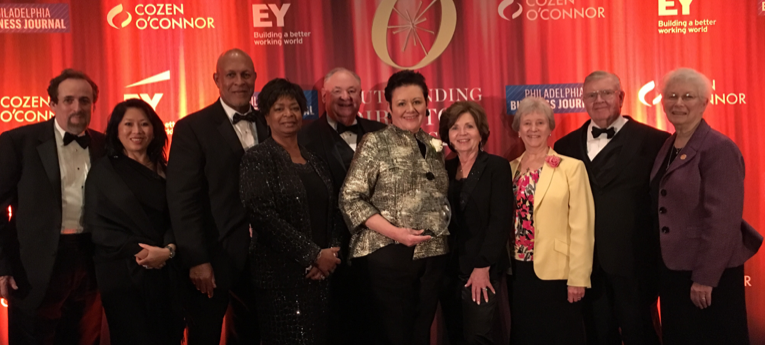The Philadelphia Business Journal recognized Nancy Dunleavy, Chair of the Board of Trustees of Gwynedd Mercy University, as one of its Outstanding Directors for 2017. The black tie awards dinner was held on February 23rd at the Union League of Philadelphia.
Nancy is the Founder & CEO of Dunleavy & Associates, a professional services firm dedicated to helping charitable organizations achieve their fullest potential.
Nominated by Dr. Kathleen Owens, the President of Gwynedd Mercy University, who went on to say, "Nancy brings such strength to our Board of Trustees, both her leadership skills, her ability to move the agenda forward and yet deal with the 25 other individuals who are active on our Board."
Nancy has been a trustee at Gwynedd Mercy since 2006 and is currently in her second term as Chairperson; she shared - "I am humbled to have been nominated by Gwynedd Mercy University and honored to have been selected among this esteemed group of colleagues.
The Philadelphia Business Journal says of its Outstanding Directors: "Behind every great company or organization is a great board of directors - people who are committed and tireless in the pursuit of excellence."
Nancy also serves on two other boards, The Board of Directors for the Union League of Philadelphia and the Alliance for Women Entrepreneurs. Additionally, in 2016, she completed nine years of service on the Valley Forge Tourism and Convention Board.
Along with Nancy, those awarded the Outstanding Director Award include:
- George W. Gephart Jr., President & CEO of the Academy of Natural Sciences; Trustee, Main Line Health board of governors who received the Lifetime Achievement Award;
- Paul Beideman, President and CEO, Avenue of the Arts Inc., Vice-chair of Widener University's Board of Trustees
- Walter Cressman, Board member of Penn Community Bank
- Lauren Dougherty, Design Director at FS Investments, Board President of AIGA Philadelphia
- Stan Silverman, Board member of Drexel University
- Lloyd Freeman, Partner at Archer, Executive board member of Big Brothers Big Sisters Independence Region
- Mark Gittelman, Chief Practice Counsel - Asset Recovery at PNC Bank, Board member of Support Center for Child Advocates
- Karen Higgins, President of A&E Communications, Immediate Past President of NAWBO Philadelphia Center for Advancing Entrepreneurs
- Mildred Joyner, President of MCJ Consultants, Board member of DNB Financial
- Jeffrey Lutsky, Managing Partner at Stradley Ronon, Board member of University of the Arts, Board member of Philadelphia Freedom Valley YMCA
- Vin Milano, CEO of Idera Pharmaceuticals, Board member of Spark Therapeutics
- Robert N.C. Nix III, Of Counsel, Obermayer, Rebmann, Maxwell & Hippel, Board member of FS Investment Corp. III
- David Pudlin, President and CEO, Hangley Aronchick Segal Pudlin & Schiller; Board member, Mural Arts Philadelphia




 By Megan Lepore
By Megan Lepore